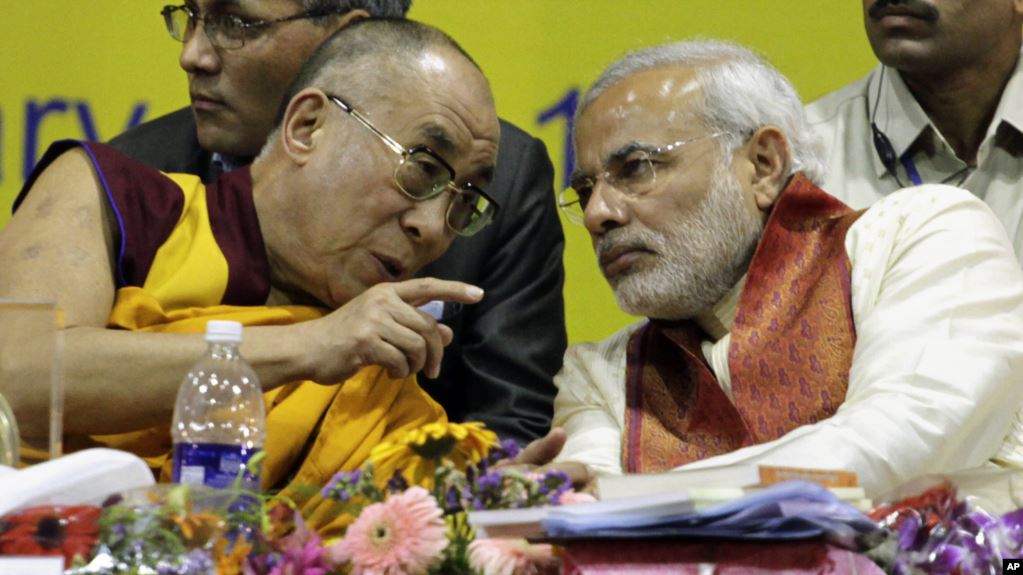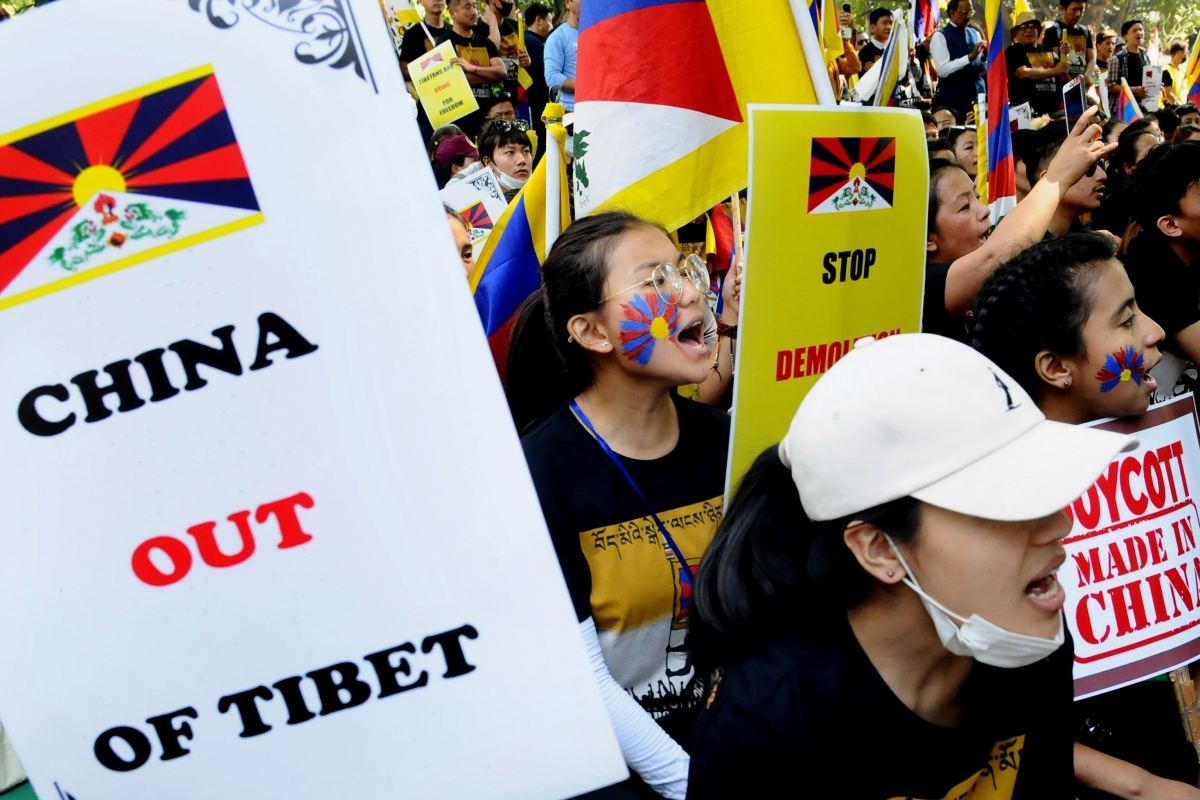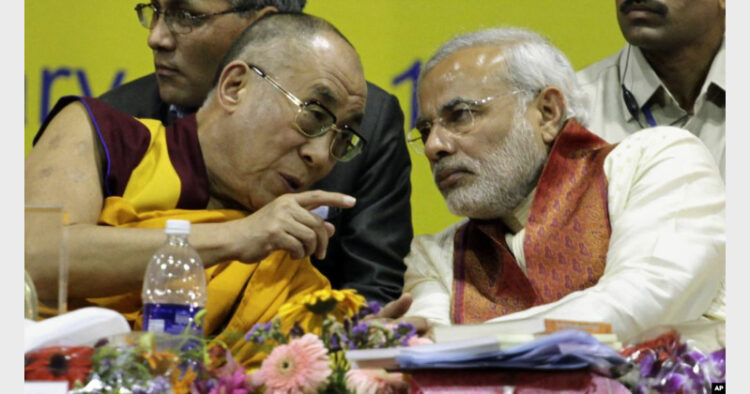If India wants to countercheck China’s sinful machinations and plans against India effectively, then Indian Government as the people will have to relocate Tibet’s real position on our national mindscape.

The Dalai Lama speaking with Narendra Modi when he was Chief Minister of Gujarat during an international seminar on Buddhist Heritage in Vadodara on January 15, 2010
India-Tibet relations date back to ages when history was not written but remembered only by epoch-making events, and man had yet to start recording it in terms of dates. Even the geographic contiguity of India and Tibet remained subordinate to the cultural integrity among the two for aeons. Tibet hosted India’s most revered God couple of Lord Shiva and Parvati while India has remained the ultimate ‘Phagyul’ (Holy Land) for Tibetans since ages. Mount Kailash and Mansarovar have always remained the ultimate destination for every Indian in a quest for peace and nirvana. Tibetans too never needed a passport or visa to visit Bodh Gaya, Rajgir, Nalanda, Sarnath or any other place in India where Lord Buddha put his holy feet.
Barter trade too was common and unhindered since time immemorial across almost every walkable pass of the Himalayas that connected Indians and Tibetans along the entire India-Tibet borders. But this oneness lasted only until Mao’s People’s Liberation Army (PLA) occupied Tibet in 1951 and China replaced Tibet as India’s new communist neighbour.
A Buffer Nation
In the recorded history of over 3000 years before 1951, not a single inch of land along nearly 4000 km long Himalayan borders of India in Ladakh, Himachal Pradesh, Uttarakhand, Nepal, Sikkim, Bhutan or Arunachal (erstwhile ‘NEFA’) had a common border with China. Not even for a day. Nor did the border posts all along this border hosted a single Chinese soldier, a Chinese flag, a Chinese post office, a Chinese business Counselor or even Chinese currency during past innumerable millennia. That was so because Tibet acted as a buffer to separate India and China by a distance of over a thousand kilometres at even the nearest points. That explains why the India-Tibet border had the distinction of being the most peaceful border in the world.
A worldwide social media campaign has been launched by freedom fighters of Tibet and followers of Dalai Lama against Communist China. The #LongLiveDalaiLama campaign is against China’s efforts to legitimise the illegal occupation of Tibet since 1959. The campaign is also to protest against China’s attempts to tarnish the image of Tibetan Buddhist and Spiritual leader Dalai Lama.

No surprise that common Tibetans refer to India as ‘Gyakar’ (White or Holy Land) and China as ‘Gyanak’ (Black, Unholy or Manhoos, i.e. ominous land). Interestingly, this public practice continues even today, rather has further perpetuated inside and outside occupied Tibet despite seven decades of harsh Chinese colonial rule of severe communist indoctrination, brainwashing and physical dominance of the Tibetan population.
Binding Power of Sanskrit
One of the strongest bonds which bind Tibet and India together is their common Buddhist heritage in all its spiritual, philosophical, academic and worldly disciplines which include fine arts, music, medicine, astrology, handicrafts and architecture. Although Buddhism spread out from India to many other countries, including China, much earlier than Tibet, yet thanks to its geographic seclusion and harsh environment, it survived and thrived in Tibet in all its fine and most authentic dimensions as compared to any other country. The main credit for this goes to the wisdom of Tibetan kings like Trisong Detsen and Srongsen Gompo who decided to choose India as Tibet’s root source of teachings, teachers, Buddhist texts and also Sanskrit as the root language for translation of Buddhist literature.
Tibetans also had another neighbour China as an alternative source for the same Buddhist wisdom as the latter offered much easier geographic approach and a more friendly climate as compared to India. But despite treacherous and challenging journey through snow-laden high mountains of Himalayas and extremely hot and hostile weather conditions for its scholars, these kings decided to send Tibetan scholars only to universities like Nalanda in India. They invited top-ranking Indian scholars like Acharya Shantrakshit and Guru Padmasambhava just because they did not want to adopt a ‘second hand’ version of Buddhism from China.
Rebirth of Lost Indian Literature
These kings and Tibetan scholars had additional wisdom of developing the Tibetan language exactly on the lines of Sanskrit script, grammar, vocabulary and syntax so that the Indian literature could be translated in its most authentic form. The scientific rules developed for translation from Sanskrit into Tibetan lead to the evolution of such a huge bank of authentic Indian literature which does not exist today in any other language of the world. Naturally, this centuries-long interaction left a deep influence on Tibet’s fine arts, performing arts, handicrafts and sciences like Ayurveda medicine, astronomy etc.
After establishing innumerable army cantonments, air force bases and nuclear arsenals over entire Tibet and Xinjiang, Beijing is currently busy in changing the demographic character of both Tibet and Xinjiang. Over the past few decades, China has been active in bringing in and transplanting millions of Han citizens from all over China. In my visits to Tibet over the past few years, I’ve noticed that the local Tibetans have been reduced to an almost meaningless minority in major cities of Tibet like Lhasa, Shigatse, Lithing etc.

PLA Air Force J-16 strike fighters in Tibet
This policy has shown some interesting results during the past six decades of Tibetan refugee life in India. Tibetan scholars have recreated over two hundred such important Sanskrit texts from surviving Tibetan literature which were believed to have been lost forever in India since the days Bakhtiyar Khilji burnt down Nalanda.
India: New Reservoir of Tibetan Culture
In 1959 Tibetan people’s uprising against the Chinese occupation failed and the massacre of Tibetan people at the hands of China’s PLA forced Dalai Lama to escape to India. About 80 thousand Tibetans followed him to take refuge in India, Nepal and Bhutan. May be as part of his repentance for allowing China to occupy Tibet, Pandit Nehru, the erstwhile Prime Minister of India, generously helped the Tibetan refugees in their rehabilitation. Modern education, occupational rehabilitation through agriculture and traditional Tibetan handcrafts production centres in an exclusive Tibetan environment in these camps has helped the Tibetan refugee community to resurrect and preserve their social and cultural life and national identity in these camps over past six decades. All this has made India today the largest reservoir of authentic Tibetan culture and national identity in the world.
From Theocracy to Democracy
Thanks to his exposure to the modern world, free Indian democratic environment and his open-minded approach, the Dalai Lama has gradually piloted the Tibetan political system from a deep-rooted theocracy to a democratic one. Starting from a handpicked and nominated Parliament and the Kashag (Cabinet of ministers) in September 1960, he has slowly converted it into a fully democratic system where Tibetan refugees, spread across the world, elect their representatives, including their Prime Minister through a secret ballot. In 2012 Dalai Lama handed over all his traditional political powers as the ‘head of State’ to the elected Kalon Tripa (Prime Minister) and later renamed the post as the Sikyong (President).
Tibet as China’s Military Garrison Against India
As far as Tibet under the Chinese colonial rule is concerned, the new Communist masters have successfully converted entire Tibet over past seven decades into its front post and a military base to deal with its newly found neighbours like India, Nepal, Bhutan and rest of South Asia. It’s successful attempts in occupying the Republic of East Turkistan (now renamed as ‘Xinjiang’ by China) in 1949, has also extended its geographic excess to entire Central Asian republics of erstwhile USSR. After establishing innumerable army cantonments, air force bases and nuclear arsenals over entire Tibet and Xinjiang, Beijing is currently busy in changing the demographic character of both Tibet and Xinjiang. Over the past few decades, China has been busy bringing in and transplanting millions of Han citizens from all over China. In my visits to Tibet over the past few years, I’ve noticed that the local Tibetans have been reduced to an almost meaningless minority in major cities of Tibet like Lhasa, Shigatse, Lithing etc.
Fire for Freedom is Alive
But the fire of winning back their national freedom has survived in the hearts of Tibetan people inside Tibet. Despite strong and ruthless Chinese controls, Tibetans continue to express their opposition to Chinese occupation through public demonstrations. Over the past few years, there have been more than 150 cases of self-immolation by Tibetans across Tibet to demand Tibet’s freedom and return of Dalai Lama. Unfortunately, the ‘civilised’ world has yet to take note of it.
Tibetans continue to express their opposition to Chinese occupation through public demonstrations. Over the past few years, there have been more than 150 cases of self-immolation by Tibetans across Tibet to demand Tibet’s freedom and return of Dalai Lama. Unfortunately, the ‘civilised’ world has yet to take note of it

In March 2019, Tibetans living in exile in India take part in a protest against China, on the annual Tibetan Uprising Day commemorating the 1959 uprising against Chinese rule
Reboot and Relocate Tibet on India’s National Mindscape
However, near-total indifference on the part of India towards the illegal occupation of Tibet by China has been baffling. Over the past seven decades, India has only acted like a helpless watcher while China has been using the occupied territories of Tibet and ‘Xinjiang’ to further encircle India by joining hands with Pakistan. The most glaring example is the China Pakistan Economic Corridor (CPEC) which includes a highway from Xinjiang up to the Arabian Sea through the Indian Territory of Pakistan Occupied Jammu Kashmir (POJK).
China used Tibetan territory as its launch pad for an attack on India in 1962 and has been using Tibet for providing training, arms, sanctuary and other resources to Naxalites (Maoists) and a wide range of anti-India militant groups of North-Eastern India. And today India is finding itself under severe threat when China has started laying its claims over most of Arunachal Pradesh by calling it as ‘Southern Tibet’ or while PLA is trying to occupy one of the most sensitive areas of Ladakh in Galwan Valley and Pangong Tso. Unfortunately, all this is happening because India refused to acknowledge that China is in illegal occupation of Tibet and is using it as a base to launch aggression against India.
It is therefore high time that New Delhi should understand Tibet’s significance to India’s national security and should attend to India’s moral, political and social responsibility towards a helpless neighbour like Tibet who has been illegally occupied by a rogue nation called China. If India wants to countercheck China’s sinful machinations and plans against India effectively, then the Indian government as the people will have to relocate Tibet’s real position on our national mindscape.
(The writer is a senior journalist, veteran Tibetologist and Chairman, Centre for Himalayan Asia Studies and Engagement)













Comments